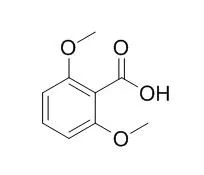| Structure Identification: |
| Acta Crystallogr C. 2012 Nov;68(Pt 11):o447-51. | | Supramolecular association in proton-transfer adducts containing benzamidinium cations. II. Concomitant polymorphs of the molecular salt of 2,6-dimethoxybenzoic acid with benzamidine.[Pubmed: 23124460] | | Two concomitant polymorphs of the molecular salt formed by 2,6-Dimethoxybenzoic acid, C(9)H(10)O(4) (Dmb), with benzamidine, C(7)H(8)N(2) (benzenecarboximidamide, Benzam) from water solution have been identified. Benzamidinidium 2,6-dimethoxybenzoate, C(7)H(9)N(2)(+)·C(9)H(9)O(4)(-) (BenzamH(+)·Dmb(-)), was obtained through protonation at the imino N atom of Benzam as a result of proton transfer from the acidic hydroxy group of Dmb. In the monoclinic polymorph, (I) (space group P2(1)/n), the asymmetric unit consists of two Dmb(-) anions and two monoprotonated BenzamH(+) cations. In the orthorhombic polymorph, (II) (space group P2(1)2(1)2(1)), one Dmb(-) anion and one BenzamH(+) cation constitute the asymmetric unit. In both polymorphic salts, the amidinium fragments and carboxylate groups are completely delocalized. This delocalization favours the aggregation of the molecular components of these acid-base complexes into nonplanar dimers with an R(2)(2)(8) graph-set motif via N(+)-H···O(-) charge-assisted hydrogen bonding. Both the monoclinic and orthorhombic forms exhibit one-dimensional isostructurality, as the crystal structures feature identical hydrogen-bonding motifs consisting of dimers and catemers. | | J Pharm Biomed Anal. 2015 Jan;102:236-45. | | Qualitative and quantitative analysis on chemical constituents from Curculigo orchioides using ultra high performance liquid chromatography coupled with electrospray ionization quadrupole time-of-flight tandem mass spectrometry.[Pubmed: 25305598] | A rapid ultra-high performance liquid chromatography coupled with electrospray ionization quadrupole time-of-flight tandem mass spectrometry (UHPLC-ESI-Q-TOF/MS) method was developed for qualitative and quantitative determination of constituents in the rhizome of Curculigo orchioides.
METHODS AND RESULTS:
Qualitative analysis was performed on a Waters ACQUITY UHPLC @ HSS T3 column (1.8 μm 100 × 2.1mm) using gradient elution with mobile phase of 0.1% formic acid and acetonitrile. Quantitative analysis was performed on an Agilent ZORBAX Eclipse plus C18 column (1.7 μm 100 × 2.1mm) using gradient elution with mobile phase of 0.1% acetic acid and acetonitrile for at least 20 min. Quadrupole TOF/MS in either full scan mode or extracted ion mode was used for qualitative and quantitative analysis of the constituents. According to the mass spectrometric fragmentation mechanism and UHPLC-ESI-Q-TOF-MS data, chemical structures of 45 constituents in the rhizome of Curculigo orchioides, including 19 phenols and phenolic glycosides, 16 lignans and lignan glycosides, 8 triterpenoid saponins, one flavone and one sesquiterpene, were identified tentatively on-line without the time-consuming process of isolation. In addition, 8 phenolic glycosides including 5-hydroxymethylfurfural (HMF), 2-hydroxy-5-(2-hydroxyethyl) phenyl-β-D-glucopyranoside (HPG), anacardoside (ACD), orcinol glucoside (OGD), orcinol-1-O-β-D-apiofuranosyl-(1 → 6)-β-D-glucopyranoside (OAG), 2,6-Dimethoxybenzoic acid (DBA), curculigoside (CUR) and curculigine A (CCL) were quantitated in 11 collected samples and 10 commercial samples from different providers.
CONCLUSIONS:
The results show that UHPLC-ESI-Q-TOF-MS is a viable method for analysis and quality evaluation of the constituents from the rhizome of Curculigo orchioides. |
|






 Cell. 2018 Jan 11;172(1-2):249-261.e12. doi: 10.1016/j.cell.2017.12.019.IF=36.216(2019)
Cell. 2018 Jan 11;172(1-2):249-261.e12. doi: 10.1016/j.cell.2017.12.019.IF=36.216(2019) Cell Metab. 2020 Mar 3;31(3):534-548.e5. doi: 10.1016/j.cmet.2020.01.002.IF=22.415(2019)
Cell Metab. 2020 Mar 3;31(3):534-548.e5. doi: 10.1016/j.cmet.2020.01.002.IF=22.415(2019) Mol Cell. 2017 Nov 16;68(4):673-685.e6. doi: 10.1016/j.molcel.2017.10.022.IF=14.548(2019)
Mol Cell. 2017 Nov 16;68(4):673-685.e6. doi: 10.1016/j.molcel.2017.10.022.IF=14.548(2019)